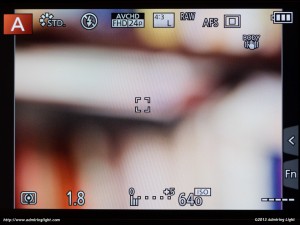Operation and Menus

The Panasonic GX7 is, much like it’s G and GH series brethren, home to a wealth of direct controls. There are four programmable function buttons on the rear of the camera body, plus another four ‘soft’ function buttons that can be accessed via a slide out panel on the touch screen. Additionally, the dedicated movie record button on top of the camera can be commandeered for additional functions as well. These can be set to a number of controls (36 to be exact) to allow for easy shooting based on your specific needs.
The rear of the camera also features a handy AF/MF switch for quickly toggling between these two focus modes, as well as a standard four-way controller with menu/set button for moving around the interface and accessing direct ISO, focus point selection, white balance and drive modes.
The option for bracketing is conveniently listed as one of the drive modes, which makes setting and changing the bracketing options quick and easy.
The GX7 has two control dials for changing the main exposure parameters: one around the shutter button and a second on the rear of the camera. The rear dial features the long-standing ‘push to change’ feature that allows further options to be utilized. The operation of the two dials can also be customized to your liking. As a result, the camera can be set up to truly meet your own distinctive needs as a photographer.

One extremely odd design choice is having flash exposure compensation essentially ‘disabled’ by default, and only changeable via a menu option. If you turn on ‘Auto Flash Exposure Compensation’ to ON in the menu system, you gain the ability to change the flash exposure compensation with the front dial by clicking the rear dial. This is handy once set, but why it isn’t the default is simply baffling to me. I spent the better part of six days with the camera before figuring out how to enable quick access to FEC.
The odd situation such as above, though, is thankfully not the norm. The main menu structure is well laid out, though each page of the menu system is a little more sparse than on most cameras. This is to make it easier to use as a touch interface, and it’s a good design decision. I found myself quickly navigating the menus via touch to modify camera settings after a day or so. The rear touch screen is useful for changing most any setting, whether using the camera’s “quick menu” for common functions, browsing images on the rear LCD, or most notably changing the location of the focus points. The GX7 offers a tremendous amount of control in a small package that is very well laid out, if a little daunting at first blush.
Performance and Autofocus

Panasonic has essentially perfected single shot autofocus on their cameras. Each new model brings small improvements to the AF algorithm, but the speed and precision that has been present since the GH2 and G3 is so fast that the small increases are not particularly perceptible. The fact is that Panasonic has the most robust single-shot autofocus of all mirrorless cameras. AF is blisteringly fast and supremely accurate. The ability to select a very small focus point and move it anywhere in the camera’s viewfinder with just a tap makes focusing on what you want fast, easy and precise.
Unfortunately, continuous autofocus is still hampered by the limitations of the contrast-detect algorithm, and as such the GX7 is not conducive to tracking motion that has any real forward or backward component.
The GX7 is a very fast camera to operate. Startup occurs in about a half a second and is ready to shoot immediately after that. Shutter lag is extremely short and the camera stays responsive when writing to the buffer. With the mechanical shutter, the GX7 is capable of shooting at shutter speeds up to 1/8000s and at burst modes up to 5 frames per second at full resolution in RAW format. With tracking autofocus enabled, burst shooting drops to slightly faster than 4 frames per second. The 5 frame per second burst mode is a little disappointing given the competition in the mirrorless market, as Olympus offers up to 10 frames per second with the E-M1 (and 9 frames per second for the older E-M5), and even Fuji’s X-E1 offers over 6 fps burst capability. You can shoot with the electronic shutter at up to 10 frames per second, though shooting high speed moving objects with an electronic shutter can lead to very odd images due to the way the lines are read off the sensor (strange motion distortion). Additionally, the electronic shutter can shoot in a super high-speed burst mode that utilizes small 4MP JPEGs at 40 frame per second.
Flash Performance
The GX7’s built-in flash works quite well and is released by sliding the switch to the left of the flash. The pop-up flash provides decent power for directly illuminated scenes, though with the less than stellar look of on-board flash. Like the GX1 before it, the GX7 can be angled upwards to provide bounce flash. I found that with a fast lens of f/2 or faster and ISO 400, I could use the GX7’s flash in bounce mode and get properly exposed images.
Using an external flashgun, the GX7 produced consistent exposure using the TTL flash system, though I found the camera was unable to produce accurate white balance using AWB and an external flash. When set to auto white balance using the external flashgun, images had a noticeable magenta cast. While it wasn’t an issue when shooting in RAW, this is something to be aware of if you are a JPEG shooter.





Leave a Reply